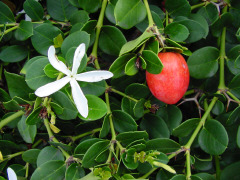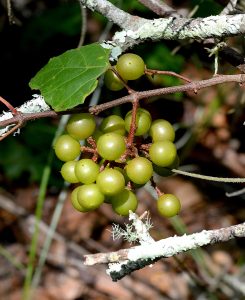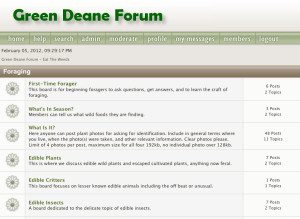
Aralia Spinosa has blossoms high above the top of the plant

Cut off an spines on the shoot, keep the large part at the bottom
Eating some plants is the best revenge, sand spurs some to mind. Another one to add to that hostile list is The Devil’s Walking Stick. I usually notice the species too late, after it has sliced a long bloody line or two on my arm or leg. The only plant I loose more blood too is the jujube.
There are several edible Aralias, and they are popular foraging food in other countries, among the edible species are Aralia elata, the Japanese Angelica tree (invasive in Northeast America). A. cordata, A nudicaulis, and A. racemosa. In the southeast ours is Aralia spinosa.
Officially the species gets to north Florida — though I have seen it in Deland in Central Florida — and I expect to see it this Saturday at my Gainesville Foraging Class. Edible parts are young spring shoots, raw or blanched/boiled. I think cooked is best, and safest. As it is in the order of araliaceae you detect a might detect a hint of parsley and or cilantro in the flavor.

A. spinosa is well-armed
One precaution is to make sure you have a true aralia. There are several ornamental plants in south Florida and other warm place commonly called “Aralia” but are not and are not edible. There is a Schefflera (elegantissima) is commonly called the False Aralia. It is not edible. Fatsia japonica, sometimes called Japanese aralia, is not edible. However, the house plant called Ming Aralia is actually Polyscias fruticosa and is edible like A. spinosa.
A. spinosa is also called Prickly ash, Hercules club, Angelica tree, Prickly elder, Pick tree, Toothache tree, and Shotbush. A separate species, Zanthoxylum clava-herculis, is also called the Toothache Tree and Hercules’ club. The latter grows into a large tree, A. spinosa is usually a spindly shrub.

Foraging classes are held rain, shine, hot or cold. Photo by Nermina Krenata
Foraging classes this weekend might have to endure heavy rain depending upon where the system in the Gulf of Mexico decides to go. Usually rain does not stop classes, named storms do.
Saturday, June 4th Boulware Springs Park, 3420 SE 15th St., Gainesville, FL 32641. 9 a.m. Meet at the picnic tables next to the pump house.
Sunday June 5th, Spruce Creek Park, 6250 Ridgewood Ave. Port Orange, 32127. 9 a.m. Meet at the pavilion.
Saturday, June 11th Florida State College, south campus, 11901 Beach Blvd., Jacksonville, 32246. 9 a.m. We meet at Building A next to the administration parking lot. Whether the college bathroom are open is always in question.
Sunday June 12th, Blanchard Park, 10501 Jay Blanchard Trail, Orlando, FL 32817. 9 a.m. Meet at the picnic shelter by the tennis courts.
For more information, to pre-pay or sign up go here

Natal plum have double sets of thorns. Photo by Green Deane
Natal plums are not plums but they are a tasty fruit which once established are extremely wind, drought and salt tolerant. This makes sense as the first time I saw them was some 35 years ago was at a beach house inside Canaveral National Park in New Smyrna Beach. For $75 we could rent the two-story place from Friday afternoon until Monday morning. It slept six, was almost across the street from “Turtle Mound” and was right on the beach, literally. The best part is we were locked in the park from sunset to sunrise giving us the entire beach to ourselves. That house had a hedge of Natal Plums on the west side. In fact just north of Bethune Beach Park there is a half-mile section of A1A that is residential and on the beach. Many of those houses have Natal Plums and where I go when I want to collect a lot of them.
Some 20 years later when I was in San Diego on business I saw Natal Plums everywhere in both commercial and residential landscaping. They can take the heat. And in Port Charlotte, Fla., where I teach some of my foraging classes, there are several Natal Plums in the area. There are some in the neighborhood where I live. Invariably when I ask the owner if I can have the fruit they have no idea they are edible. I find most of the Natal Plums when I’m driving. When I spy a dark green hedge with plum-size red fruit it’s almost always the Natal Plum. Although it’s closely related to the deadly Oleander there is a large, commercial variety of the species available. And while various fruit councils have championed the species for decades it never really took off as a commercial fruit. You can read about it here.

Suriname Cherry might be an acquired taste.
While on the topic of wild fruit Chickasaw Plums should ripen soon.They are late this year. I have never found any Chickasaw Plum fruit after the Fourth of July but this year might be different. Also ripening are the Surinam Cherries. They are perhaps an aquired taste Some people dislike them intensely .There are also two varieties, the deep red shown left and a dark purple variety (which I think is sweeter and less acidic.) If you eat them when orange red they are not pleasant tasting.

Vitis munsoniana getting close to ripening. Photo by Green Deane
The general calendar date for grapes them is September first. In Maine in the past school always started the Tuesday after Labor Day. A couple of weeks later I’d be late for school and home because of grapes and apples. I walked two miles each way and that took me past hedgerows of Concord Grapes. A couple of weeks after that apples in the nearby orchard got my attention. Before modern slang “scrumping” meant stealing local fruit usually by kids. And that I did though most of these vines and trees were around old farmsteads and not tended. Locally grapes have shown up in August even late July. These are in the single-tendril clumpinggroup. I suspect the forked-tendril bunch grapes will wait until September to ripen. You can watch my video on grapes here and read about them here.

You get the USB, not the key.
My nine-DVD set of 135 videos has been phased out and replaced by 171-videos on a 128-GB USB, see left. The USB videos are the same videos I have on You Tube. Some people like to have their own copy especially if social order falters. The USB videos have to be copied to your computer to play. If you want to order the USB go to the DVD/USB order button on the top right of this page or click here. That will take you to an order form. Or you can make a $99 donation, which tells me it is for the USB (include a snail-mail address.) I’d like to thank all of you who ordered the DVD set over the years which required me to burn over 5,000 DVDs individually. I had to stop making them as few programs now will read the ISO files to copy them. Burning a set also took about three hours.

Green Deane Forum
Want to identify a plant? Perhaps you’re looking for a foraging reference? You might have a UFO, an Unidentified Flowering Object, you want identified. On the Green Deane Forum we — including Green Deane and others from around the world — chat about foraging all year. And it’s not just about warm-weather plants or just North American flora. Many nations share common weeds so there’s a lot to talk about. There’s also more than weeds. The reference section has information for foraging around the world. There are also articles on food preservation, and forgotten skills from making bows to fermenting food. Recent topics include: Fermenting potatoeswith yogurt, make a water filter, nixtamalization at home, Stale Bread and Cod Liver Oil, Life’s a Grind, Killing Bugs with Tobacco Plugs, Eating weeds: Is it safe? Have they mutated? Not the Eastern Red Bug but the Pink Tabebuia, African Tulip Tree, Asparagus densiflorus, Green Deane’s Book… You can join the forum by clicking on the button on the upper right hand side of this page.
This is my weekly newsletter #510. If you want to subscribe to this free newsletter you can find the sign-up form in the menu at the top of the page. My website, EatTheWeeds.com, which is data secure, has over 1500 plants on it in some 428 articles. I wrote every one myself, no cut and paste.
To donate to the Green Deane Newsletter click here.


